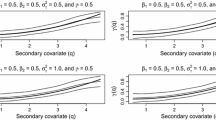Abstract
We propose a hidden Markov model for longitudinal count data where sources of unobserved heterogeneity arise, making data overdispersed. The observed process, conditionally on the hidden states, is assumed to follow an inhomogeneous Poisson kernel, where the unobserved heterogeneity is modeled in a generalized linear model (GLM) framework by adding individual-specific random effects in the link function.
Due to the complexity of the likelihood within the GLM framework, model parameters may be estimated by numerical maximization of the log-likelihood function or by simulation methods; we propose a more flexible approach based on the Expectation Maximization (EM) algorithm. Parameter estimation is carried out using a non-parametric maximum likelihood (NPML) approach in a finite mixture context. Simulation results and two empirical examples are provided.
Similar content being viewed by others
References
Aitkin, M.: A general maximum likelihood analysis of overdispersion in generalized linear models. Stat. Comput. 6, 251–262 (1996)
Alfó, M., Trovato, G.: Semiparametric mixture models for multivariate count data, with application. Econom. J. 7, 1–29 (2004)
Bago d’Uva, T.: Latent class models for utilisation of health care. J. Health Econ. 15, 329–343 (2006)
Baum, L.E., Petrie, T., Soules, G., Weiss, N.: A maximization technique occurring in the statistical analysis of probabilistic functions of Markov chains. Ann. Math. Stat. 41, 164–171 (1970)
Böhning, D.: The EM algorithm with gradient function update for discrete mixtures with known (fixed) number of components. Stat. Comput. 13, 257–265 (2003)
Cappé, O., Moulines, E., Rydén, T.: Inference in Hidden Markov Models. Springer, New York (2005)
Gueorguieva, R.: A multivariate generalized linear mixed model for joint modelling of clustered outcomes in the exponential family. Stat. Model. 1, 177–199 (2001)
Heckman, J., Singer, B.: A method for minimizing the impact of distributional assumptions in econometric models of duration. Econometrica 52, 271–320 (1984)
Hinde, J.P., Wood, A.T.A.: Binomial variance component models with a non-parametric assumption concerning random effects. In: Crouchley, R. (ed.) Longitudinal Data Analysis. Averbury, Hants (1987)
Hughes, P.J., Guttorp, P., Charles, S.P.: A non-homogeneous hidden Markov model for precipitation occurrence. Appl. Stat. 48, 15–30 (1999)
Knorr-Held, L., Raßer, S.: Bayesian detection of clusters and discontinuities in disease maps. Biometrics 56, 13–21 (2000)
Leroux, B.G., Puterman, M.L.: Maximum-penalized-likelihood estimation for independent and Markov dependent mixture models. Biometrics 48, 545–558 (1992)
Lindsay, B.G.: The geometry of mixture likelihoods: a general theory. Ann. Stat. 11, 86–94 (1983a)
Lindsay, B.G.: The geometry of mixture likelihoods, part II: the exponential family. Ann. Stat. 11, 783–792 (1983b)
MacDonald, I.L., Zucchini, W.: Hidden Markov Models and Other Models for Discrete-Valued Time Series. Chapman & Hall, London (1997)
MacKay, R.J.: Estimating the order of a hidden Markov model. Can. J. Stat. 30, 573–589 (2002)
MacKay, R.J.: Mixed hidden Markov models: an extension of the hidden Markov model to the longitudinal data setting. J. Am. Stat. Assoc. 102, 201–210 (2007)
McLachlan, G.J., Peel, D.: Finite Mixture Models. Wiley, New York (2000)
Min, Y., Agresti, A.: Random effect models for repeated measures of zero-inflated count data. Stat. Model. 5, 1–19 (2005)
Munkin, M.K., Trivedi, P.K.: Simulated maximum likelihood estimation of multivariate mixed-Poisson regression models, with application. Econom. J. 2, 29–48 (1999)
Newhouse, J.P., the Insurance Experiment: Free for All? Lessons from the RAND Health Insurance Experiment. Harvard University Press, Cambridge (1993)
Poskitt, D.S., Zhang, J.: Estimating components in finite mixtures and hidden Markov models. Aust. N. Z. J. Stat. 47, 269–286 (2005)
van Ophem, H.: Modeling selectivity in count data models. J. Bus. Econ. Stat. 18, 503–510 (2000)
Wang, P., Puterman, M.L.: Analysis of longitudinal data of epileptic seizure counts—a two-state hidden Markov regression approach. Biom. J. 43, 941–962 (2001)
Author information
Authors and Affiliations
Corresponding author
Rights and permissions
About this article
Cite this article
Maruotti, A., Rydén, T. A semiparametric approach to hidden Markov models under longitudinal observations. Stat Comput 19, 381 (2009). https://doi.org/10.1007/s11222-008-9099-2
Received:
Accepted:
Published:
DOI: https://doi.org/10.1007/s11222-008-9099-2



